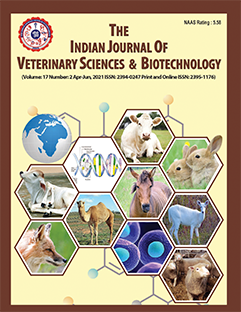Surgical Management of Persistent Hymen in a Marwari Filly - A Case Report
DOI:
https://doi.org/10.48165/ijvsbt.21.6.40Keywords:
Caslick's Procedure, Equine, Persistent Hymen, communicationAbstract
Persistent hymen is a rare congenital anomaly of the female genital tract and an important cause of infertility in domestic animals. The hymen is formed from the epithelial lining of the paramesonephric ducts and the urogenital sinus at the vestibulo vaginal junction. Normally, it appears as a thin mucosal fold which regresses or ruptures spontaneously during the first estrus or coitus. However, incomplete canalization of the embryonic vaginal septum results in persistence of this membrane as a partial or complete transverse barrier (Roberts, 1986). Such persistence is considered a form of segmental aplasia caused by embryonic malunion of the paramesonephric ducts and the ectodermal urogenital sinus, leaving incomplete communication between the caudal vagina and the vestibule. The degree of obstruction varies, ranging from a partially occluding membrane to complete imperforation. Complete obliteration of the vaginal canal prevents normal drainage of secretions, resulting in their accumulation within the vagina, cervix, and uterus. This leads to conditions such as mucovagina, mucocervix, and mucometra (Parkinson, 2001). Once the vagina becomes distended, affected animal may exhibit discomfort, straining, and tenesmus. Reports of persistent hymen are uncommon in domestic species. It has been documented in cattle (Madhusudhan et al., 2016; Kumar et al., 2017), buffaloes (Kumar et al., 2016), bitches (Kruger et al., 2025), and goats (Da Silva et al., 2025). The anomaly has also been reported sporadically in camels, llamas, and alpacas (Fowler, 2011) and even in human beings, where it is a well recognised cause of primary amenorrhea and pelvic pain (Lee et al., 2019). Although rare in equines, persistent hymen can interfere with normal reproductive tract function, predispose to infection, and cause breeding difficulties. The present case report describes the clinical presentation, diagnosis, and successful surgical management of persistent hymen in a Marwari filly.
Downloads
References
Da Silva, P.N., Waters, K., Maxwell, H., Chamorro, M.F., Rodriguez, D.A.M., Cole, R., Douglas, J.M., & Boakari, Y. (2025). Pyometra resulting from a persistent hymen in a Pygmy goat doe. Canadian Veterinary Journal, 66(5), 533–536.
Dascanio, J.J. (2021). Caslick operation or vulvoplasty. In Equine Reproductive Procedures (pp. 191–194). John Wiley & Sons, Iowa, USA.
Fowler, M. (2011). Medicine and Surgery of Camelids (3rd ed.). John Wiley & Sons, Iowa, USA.
Kruger, T.J., Kitshoff, A., Schoeman, J.P., Hoepner, S.N., & Hanekom, J. (2025). A persistent hymen resulting in an open cervix but closed pyometra and pyocolpos in a mixed-breed female domestic dog. Veterinary Records: Case Reports, e70165.
Kumar, B., Krishnappa, B., Das, G.K., Sharma, G.C., Yadav, D., & Jan, M.H. (2016). Imperforate hymen and subsequent secondary pyometra, pyocervix and pyovagina in Murrah buffalo heifer: A case report. Buffalo Bulletin, 35(1), 19–21.
Kumar, P., Sharma, A., & Singh, M.M. (2017). Clinical management of persistent hymen with mucocervix and mucovagina in crossbred heifer. Intas Polivet, 18(1), 36–37.
Lee, K.H., Hong, J.S., Jung, H.J., Jeong, H.K., Moon, S.J., Park, W.H., Jeong, Y.M., Song, S.W., Suk, Y., Son, M.J., Lim, J.J., & Shin, J.I. (2019). Imperforate hymen: A comprehensive systematic review. Journal of Clinical Medicine, 8(1), 56.
Madhusudhan, S.V., Promod, K., Chacko, L., & Soorya, D. (2016). Imperforate hymen and pyometra in a crossbred heifer: A case report. Shanlax International Journal of Veterinary Science, 4(1), 18–20.
Parkinson, T.J. (2001). Infertility in the cow: Structural and functional abnormalities, management and non-specific infection. In D.E. Noakes, T.J. Parkinson, & G.C.W. England (Eds.), Arthur’s Veterinary Reproduction and Obstetrics (8th ed.). Saunders, Philadelphia, USA.
Roberts, S.J. (1986). Veterinary Obstetrics and Genital Diseases (3rd ed.). Edwards Brothers, Michigan, USA.
Downloads
Published
Issue
Section
License
Copyright (c) 2025 Indian Journal of Veterinary Sciences and Biotechnology

This work is licensed under a Creative Commons Attribution-NonCommercial-NoDerivatives 4.0 International License.




